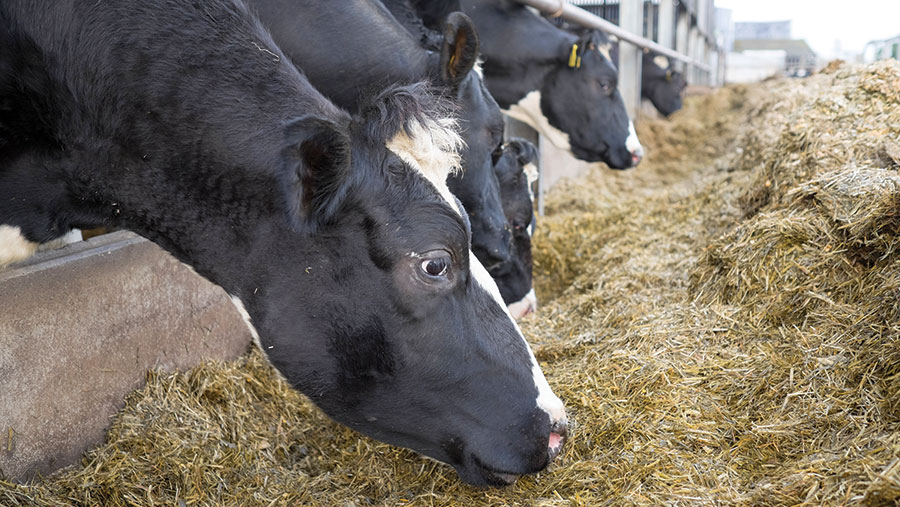Overfat heifers being culled early, warns nutritionist
 © Tim Scrivener
© Tim Scrivener Heifer-rearing rations require careful balancing between weaning and insemination to avoid excess energy and fat heifers calving down with ketosis and other transitional issues.
The issue of overconditioned heifers is affecting cow longevity, warned Stefan Neumann of nutrition company Agrosom. He was speaking at the European Calf Conference held in Bremen last week (12-13 March).
“Approximately 25% of heifers are culled by the end of the first lactation, and one of the key factors is transition and ketosis, caused by being overfat,” explained Mr Neumann.
He said scrutinising energy intake when heifers weigh 250-300kg and thereafter is critical, as this period is when fat deposition starts to physiologically overtake muscle building.
See also: 4 steps to ensure heifers are on track to calve at 24 months
Take-home messages
- Weigh as often as possible to understand your heifer growth (birth, weaning, insemination)
- Analyse all forage
- Weigh feed and calculate dry matter intake, if possible
- Evaluate whether you are overfeeding energy at the 250-300kg stage
- Manage feed intake and fat deposition with neutral detergent fibre
- Pasture is a good solution for controlling body condition in pregnant heifers, but must be managed well
- Talk to your nutritionist about supplying enough protein
Mr Neumann stressed some heifers are not developing structurally fast enough, due to low protein levels in rations, and are laying down too much fat because of high energy levels.
At a rough cost of €1,500-€2,000 (£1.300-£1,800) to rear each heifer in Germany, Mr Neumann said it is worth analysing forage to ensure money isn’t being wasted on bought-in energy.
Heifer-rearing feed costs total £1,051 a head alone, before vet and med at £22 and fixed costs at £140. Pre-weaning feeding costs £350, the 100-250kg growing stage costs £150 and feeding a heifer weighing 250-600kg costs about £536.
German feeding concept
Mr Neumann detailed a rough heifer feeding programme with guideline energy and protein requirements to meet the desired condition at first calving (see table below).
Weaning-to-insemination feeding programme to calve at 22-24 months |
||||
|
Months old |
Live weight kg at end of period |
Average dry matter intake (kg) |
Management and feeding |
Energy (ME)/ crude protein (%) |
|
3 |
120 |
2.5-3 |
Weaning, weighing, introduce new diet |
11.5/18 |
|
6-7 |
230-250 |
5.5-6 |
Two-thirds corn silage, one-third grass silage 2.5kg soya bean meal/corn 0.1kg mineral |
11.2/17.5 |
|
7-12 |
250-360 |
6-7.2 |
Two-thirds corn silage, one-third grass silage 2.5-3kg soya bean meal/corn 0.1kg mineral |
10.8/17 |
Use fibre
He said a tried-and-tested way of controlling energy intake is by feeding dietary fibre.
Depending on feed palatability and energy density, neutral detergent fibre (NDF) should be fed accordingly.
NDF recommendations |
||
|
NDF (g/kg DM) |
Feed intake (kg DM/day) |
|
|
|
300kg liveweight |
500kg liveweight |
|
350 |
8.6 |
14.3 |
|
400 |
7.5 |
12.5 |
|
450 |
6.7 |
11.1 |
|
500 |
6 |
10 |
|
550 |
5.5 |
9.1 |
Pasture management
Pasture grazing is one way to control energy in the diet, with the option to supplement early or late in the season as grass quality alters, said Mr Neumann.
But he stressed altering stocking rates is vital. A German study found the pasture requirements of 400kg heifers gaining 700g a day increased from 0.25ha a heifer a month in May to 1.05ha in October.
A 500kg heifer growing at 700g a day needed 0.31ha in May, which increased to 1.27ha in October.
Weight targets
He advised farmers to reassess what size cows they are trying to breed and feed accordingly.
Optimal weights and sizes, rather than maximum weights and sizes, had the best yield benefit in first lactation, he explained.
He said a target body weight of 561kg-600kg for a Holstein-Friesian heifer after calving is optimal, with a height of 1.41-1.43m at the sacrum.
“Danish breeders are now advising a maximum of 1.48m,” he said.
